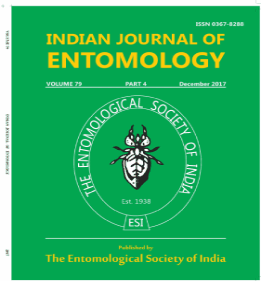Functional Capabilities of Spiders in Support of Sustainable Agriculture
DOI:
https://doi.org/10.55446/IJE.2022.689Keywords:
Diversity, spiders, agricultural pests, sustainable development, organic farmingAbstract
Modern agricultural techniques have a detrimental effect on ecosystems, and hence ecofriendly agriculture is required for sustainable agriculture with biodiversity conservation. Spiders play a vital role in keeping pest populations under control as an alternative to chemical pesticides. This study assessed the functional diversity of spiders to control pest populations by estimating their diversity in diurnal and seasonal appearance, preferred microhabitats, and hunting strategies. From August 2020 to November 2021, random quadrate sampling was undertaken in cultivated and wild plant communities. A metaanalysis of the ecology and diversity found that spiders have the capability to provide biological pest control against a wide variety of pests in Odisha’s coastal environment.
Downloads
Metrics
Downloads
Published
How to Cite
Issue
Section
References
Bellotti A, van Schoonhoven A. 1978. Mite and insect pests of cassava. Annual Review of Entomology 23(1): 39-67.
Dhaliwal G S, Jindal V, Mohindru B. 2015. Crop losses due to insect pests: global and Indian scenario. Indian Journal of Entomology 77(2): 165-168.
Dumanski J, Peiretti R, Benites J R, McGarry D, Pieri C. 2006. The paradigm of conservation tillage. Proceedings. World association of soil and water conservation 1: 58-64.
García-Frapolli E, Ayala-Orozco B, Bonilla-Moheno M, Espadas- Manrique C, Ramos-Fernández G. 2007. Biodiversity conservation, traditional agriculture and ecotourism: Land cover/land use change projections for a natural protected area in the northeastern Yucatan Peninsula, Mexico. Landscape and Urban Planning 83(2-3): 137-153.
Garratt M P D, Wright D J, Leather S R. 2011. The effects of farming system and fertilisers on pests and natural enemies: a synthesis of current research. Agriculture, Ecosystems and Environment 141(3-4): 261-270.
Jocqué R and Dippenaar-Schoeman A S. 2007. Spider families of the world. Royal Museum for Central Africa. pp. 1-336.
Letourneau D K, Bothwell S G. 2008. Comparison of organic and conventional farms: challenging ecologists to make biodiversity functional. Frontiers in Ecology and the Environment 6(8): 430-438.
Mahdi S S, Hassan G I, Samoon S A, Rather H A, Dar S A, and Zehra B. 2010. Biofertilisers in organic agriculture. Journal of phytology 2(10): 42-54.
Norris K. 2008. Agriculture and biodiversity conservation: opportunity knocks. Conservation letters 1(1): 2-11.
Parayil G. 1992. The Green Revolution in India: A Case Study of Technological Change. Technology and culture 33(4): 737-756. https://doi.org/10.2307/3106588
Pekár S. 2012. Spiders (Araneae) in the pesticide world: an ecotoxicological review. Pest management science 68(11): 1438-1446.
Pierce F J, Nowak P. 1999. Aspects of precision agriculture. In Advances in Agronomy 67: 1-85.
Pindi P K, Satyanarayana S. 2012. Liquid Microbial Consortium-A Potential Tool for Sustainable Soil Health. Journal of Biofertilizers and Biopesticides 3(4): 1-9. https://doi.org/10.4172/2155-6202.1000124
Praburaj L, Design F, Nadu T. 2018. Role of agriculture in the economic development of a country. Shanlax International Journal of Commerce 6(3): 1-5.
Puech C, Baudry J, Joannon A, Poggi S, Aviron S. 2014. Organic vs. conventional farming dichotomy: does it make sense for natural enemies?. Agriculture, Ecosystems and Environment 194: 48-57.
Rathee M, Dalal P. 2018. Emerging insect pests in Indian agriculture. Indian Journal of Entomology 80(2): 267-281.
Samu F, Szinetár C. 2002. On the nature of agrobiont spiders. The Journal of Arachnology 30(2): 389-402. https://doi.org/10.1636/01618202(2002)030[0389:OTNOAS]2.0.CO;2
Singh R P. 2013. Status paper on pulses. Government of India ministry of agriculture, department of agriculture & cooperation, Bhopal, Madhya Pradesh. pp. 1-215.
Sunderland K. 1999. Mechanisms underlying the effects of spiders on pest populations. Journal of Arachnology 27(1): 308-316. https://www.jstor.org/stable/3706002
Tikader B K. 1980. The fauna of India (Araneae). Records of the Zoological Survey of India 1,2: 1-446.
Tikader B K. 1987. Handbook Indian Spider. Zoological Survey of India. pp. 1-251
World Spider Catalog. 2022. World Spider Catalog. Version 23.5. Natural History Museum Bern, online at http://wsc.nmbe.ch.doi:10.24436/2
Xu Q C, Fujiyama S, Xu H L. 2011. Biological pest control by enhancing populations of natural enemies in organic farming systems. Journal of Food, Agriculture and Environment 9(2): 455-463.
Yadav S K, Babu S, Yadav M K, Singh K, Yadav G S, Pal S. 2013. A review of organic farming for sustainable agriculture in Northern India. International Journal of Agronomy 2013: 1-8. https://doi. org/10.1155/2013/718145















